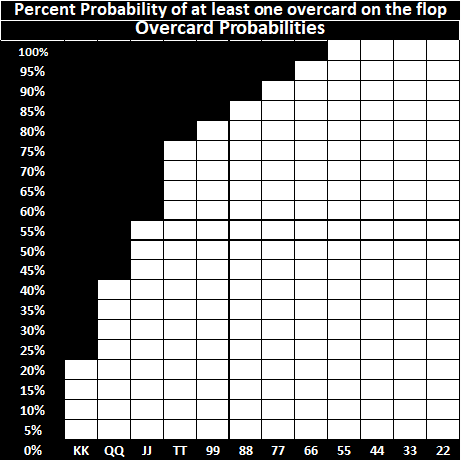Home » Over Pair Probabilities – Pre-Flop
OVER-PAIR PROBABILITIES
PRE-FLOP
In the game of Texas Hold’em, understanding the probability of over-cards appearing on the board when holding a pocket pair is crucial for making informed decisions. Knowing the likelihood of facing higher cards can significantly influence your strategy. Regardless, whether you aim to maintain control of the hand or simply avoid potential pitfalls. This article delves into the over-card probabilities on the flop, turn, and river, offering valuable insights for players at all levels.
Many players often find themselves uncertain about the strength of their pocket pairs. This is especially true when higher cards are a concern. By analyzing these probabilities, you can better gauge when to play aggressively and proceed cautiously. Understanding these odds enhances your decision-making process and improves your overall gameplay.
WHAT DOWS YOUR OPPONENTS HAVE - PRE-FLOP?
Moreover, we will discuss the probability of another player holding a higher pocket pair than yours. Many players overlook this aspect of the game, but it plays an essential role in a well-rounded strategic approach. We will provide a step-by-step guide on calculating the probability of encountering higher pocket pairs. This will allow you to make more precise decisions at the table
We will break down the likelihood of over-cards appearing at each stage of the game and explore the potential of facing higher pocket pairs. This comprehensive guide will empower you to refine your strategy and boost your confidence at the table. Let’s dive into the fascinating world of poker probabilities and uncover the math behind the game!.

OVER-PAIR
When you’re dealt a pocket pair in Texas Hold’em, it’s essential to consider that another player may hold a higher pocket pair. This over-pair probability pre-flop is crucial in determining your hand’s relative strength. Pocket pairs are generally strong starting hands. A higher pocket pair can significantly reduce your chances of winning the pot.
To calculate the probability of encountering an over-pair, consider the number of combinations of higher-pocket pairs that other players might have. For instance, if you’re holding pocket eights, the potential for an opponent to have pocket nines, tens, jacks, queens, kings, or aces must be factored into your decision-making process. This assessment helps you understand the over-card probability and adjust your strategy accordingly.
Understanding these probabilities is essential because it informs your decisions on whether to raise, call, or fold. Overestimating the strength of your pocket pair without considering the likelihood of facing a higher pair can lead to costly mistakes. By incorporating the knowledge of over-pair probabilities into your strategy, you can make more informed and profitable decisions at the poker table.
CALCULATING OVER-PAIR PROBABILITIES
Let’s say you have pocket eights. Understanding the probability that another player may have a higher pocket pair is essential. This over-card probability helps you assess the relative strength of your hand and make strategic decisions.
To calculate this probability, consider the six pocket pairs that can beat your eights: nines, tens, jacks, queens, kings, and aces. With nine players in the hand, a quick estimation method involves multiplying the number of higher pocket pairs (6) by the number of players (9). The formula is as follows:
6 (higher pocket pairs) × 9 (players) = 54
Next, divide the result by 2 to convert it into a percentage, resulting in an approximate probability of 27%. Although this estimation provides a rapid calculation, the actual probability for pocket eights, with nine players in the hand, is closer to 26%. The slight difference is due to more precise combinatorial calculations used in detailed poker probability analysis.


OVER-PAIR GUIDE
The chart to the left outlines the possible 13 pocket pairs, the number of players in the hand, and the corresponding probabilities of another player having a higher pocket pair. This detailed table provides a more accurate understanding of the risks associated with your pocket pair in multi-player situations.
While the quick estimation method may not be perfectly accurate, it is “close enough” for practical use during live play, where quick decisions are often required. By understanding these probabilities, you can better evaluate the strength of your hand and make more informed choices, ultimately enhancing your overall poker strategy and performance at the table.
OVER-CARD PROBABILITIES TO YOUR POCKET PAIR
When holding a pocket pair in Texas Hold’em, it is crucial to consider the over-card probability on the flop, turn, and river. Higher cards’ appearance can significantly impact your hand’s strength and influence your strategic decisions. Understanding these probabilities is key to navigating the game effectively and making informed choices.
Over-cards are any community cards higher than your pocket pair. For pocket eights, these include nines, tens, jacks, queens, kings, and aces. The probability of one or more of these over-cards appearing increases as more community cards are revealed. This can make your hand vulnerable to being outdrawn or dominated by opponents with higher pairs or potential straights.


COMBINED THREAT: OVER-CARDS & OVER-PAIR
In addition to being cautious about potential over-cards, it’s essential to remember that there is also a 27% probability that another player has a higher pocket pair than your eights. This means that even before the flop, there is a significant chance that an opponent holds nines, tens, jacks, queens, kings, or aces, which can dominate your hand. Being aware of this possibility helps you to better assess your hand’s strength relative to your opponents’ potential holdings.
The risk associated with over-cards and higher pocket pairs underscores the importance of carefully assessing the board and your opponent’s actions. When an over-card appears, or you suspect another player has a higher pocket pair, your pocket eights may no longer be the best hand. You must consider whether an opponent has connected with the board or holds a stronger starting hand. This consideration is crucial for deciding whether to bet, call, or fold, as overvaluing your hand can lead to costly mistakes.
CONCLUSION
Being aware of the over-card probability and the chance of facing a higher pocket pair when holding pocket eights or any pair is essential for making informed decisions in Texas Hold’em. By understanding these factors, you can better gauge the strength of your hand and adjust your strategy accordingly, ultimately enhancing your gameplay and decision-making at the table.
